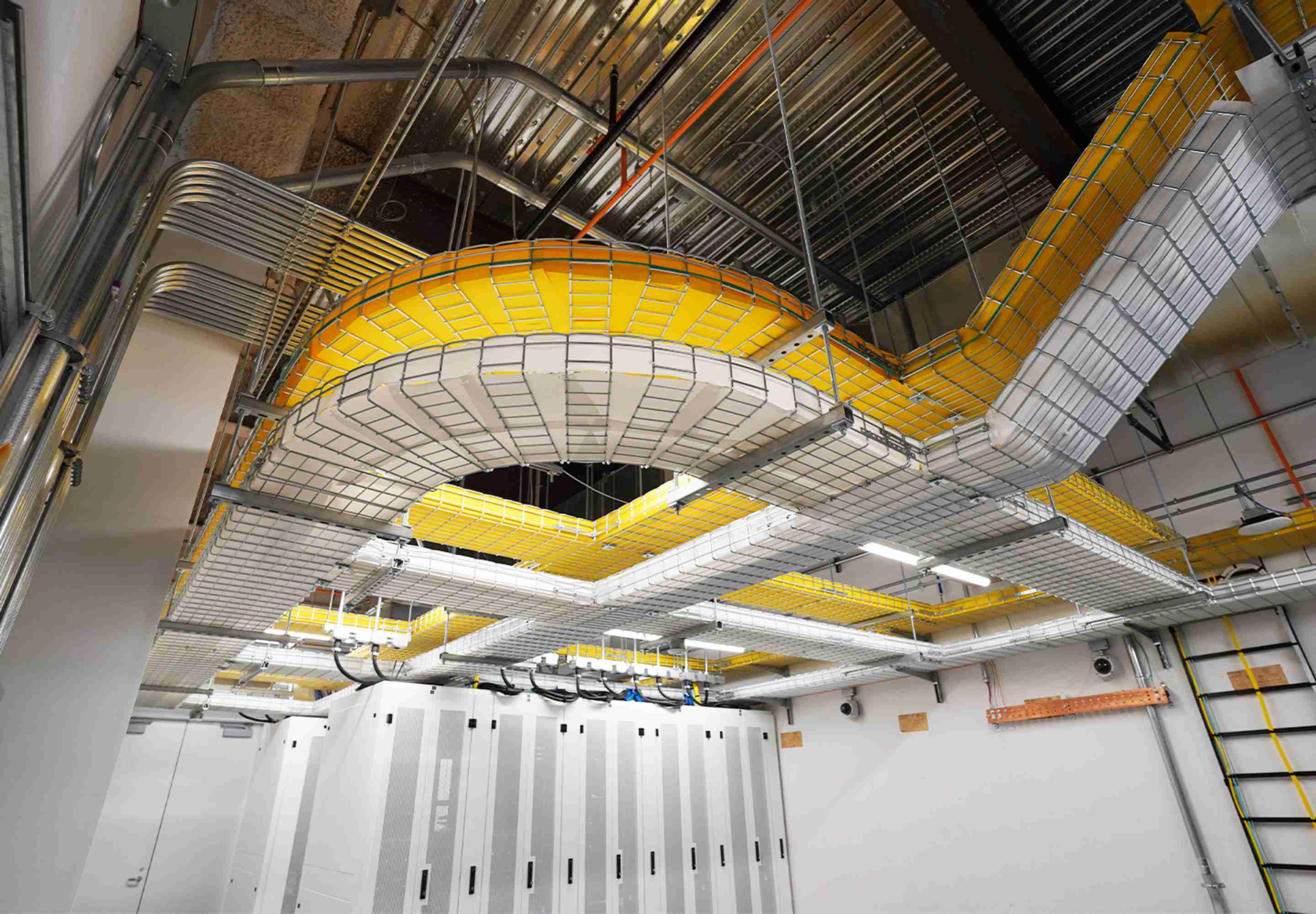-
Featured services
Harness innovation to deliver value
Ensure short-term stability as you design a roadmap for new use cases in your industry with emerging technologies.
Explore Connected Industries -
Services
View all services and productsLeverage our capabilities to accelerate your business transformation.
-
Services
Network as a Service
Popular Products
-
Private 5G
Our turnkey private 5G network enables custom-built solutions that are designed around unique use cases and strategies, and deployed, run and optimized through a full network-as-a-service model.
-
Managed Campus Networks
Our Managed Campus Networks services transform campus networks, corporate area networks and interconnected local area networks, and connect smart places and industries.
-
-
Services
Cloud Services
Popular Products
-
Cloud Migration and Transformation Services
Access the people, processes and technologies you need to deliver cloud migration projects that improve your return on investments.
-
Site Reliability Engineering Services
Get the most from your cloud investments when you harness our Site Reliability Engineering Services to support app development and lifecycle management.
-
-
Services
Edge as a Service
Client stories
-
Penske Entertainment and the NTT INDYCAR SERIES
Together with Penske Entertainment, we’re delivering digital innovations for their businesses – including INDYCAR, the sanctioning body of the NTT INDYCAR SERIES – and venues such as the iconic Indianapolis Motor Speedway, home to the Indianapolis 500.
-
Using private wireless networks to power IoT environments with Schneider Electric
Our combined capabilities enable a secure, end-to-end digital on-premises platform that supports different industries with the benefits of private 5G.
-
-
Services
Technology Solutions
Client stories
-
Services
Global Data Centers
-
Services
Digital Collaboration and CX

IDC MarketScape: Worldwide Datacenter Services 2023 Vendor Assessment
We provide a new kind of intelligent infrastructure to deliver better outcomes through technology.
Get the IDC MarketScape -
-
-
Insights
Recent Insights
-
The Future of Networking in 2025 and Beyond
-
Using the cloud to cut costs needs the right approach
When organizations focus on transformation, a move to the cloud can deliver cost savings – but they often need expert advice to help them along their journey
-
Make zero trust security work for your organization
Make zero trust security work for your organization across hybrid work environments.
-
-

Copilot for Microsoft 365
Everyone can work smarter with a powerful AI tool for everyday work.
Explore Copilot today -
-
Global Employee Experience Trends Report
Excel in EX with research based on interviews with over 1,400 decision-makers across the globe.
Get the EX report -
Discover how we accelerate your business transformation
-
About us
CLIENT STORIES
-
Liantis
Over time, Liantis – an established HR company in Belgium – had built up data islands and isolated solutions as part of their legacy system.
-
Randstad
We ensured that Randstad’s migration to Genesys Cloud CX had no impact on availability, ensuring an exceptional user experience for clients and talent.
-
-
CLIENT STORIES
-
Liantis
Over time, Liantis – an established HR company in Belgium – had built up data islands and isolated solutions as part of their legacy system.
-
Randstad
We ensured that Randstad’s migration to Genesys Cloud CX had no impact on availability, ensuring an exceptional user experience for clients and talent.
-
-
CLIENT STORIES
-
Liantis
Over time, Liantis – an established HR company in Belgium – had built up data islands and isolated solutions as part of their legacy system.
-
Randstad
We ensured that Randstad’s migration to Genesys Cloud CX had no impact on availability, ensuring an exceptional user experience for clients and talent.
-

NTT DATA and HEINEKEN
HEINEKEN revolutionizes employee experience and collaboration with a hybrid workplace model.
Read the HEINEKEN story -
- Careers
Topics in this article
Everyone knows that users connect to data centers and clouds over the public internet. But, data centers, cloud providers, colocation facilities, and even edge infrastructure sites, need more than simple connections to deliver seamless, predictable responsiveness. They need an overlapping mesh of connections. Or, to put it simply, interconnection.
Today, most organizations have more than one data center, most use more than one cloud, and many are evolving toward hybrid, multi-cloud infrastructures that span many sites in many countries.
Data suggests that around 40% of organizations' workloads run in a combination of private and hybrid cloud, while the remaining 60% is split evenly between public cloud and internal infrastructures. That means there is a significant amount of network traffic crisscrossing between data centers, cloud providers, cloud customers, and ultimately, users.
Therein lies the challenge for organizations operating these hybrid infrastructures. More often than not, the public internet isn’t fast or reliable enough to keep up with the traffic.
That's why having the right interconnection strategy is critical. If your organization operates on a hybrid model, a viable interconnection strategy ensures that you can distribute workloads across your entire infrastructure. So, instead of disparate nodes, you get an integrated, resilient mesh.
Those are the broad strokes of why interconnection still matters and will only continue to grow in importance for businesses. Here are five use cases to consider:
1. Cloud connectivity
When surveyed for Flexera's 2021 State of the Cloud report, 92% of respondents reported having a multicloud strategy while 82% said they are taking a hybrid approach—using a mix of public and private clouds. This statistic underscores the scale of network traffic moving in and out of the cloud. If your organization needs to leverage private, secure connections from the data center to major cloud service providers for compute, storage, network, and other services without going over the public internet, you need to ensure that the connection is absolutely reliable.
2. Multicloud connectivity
As you can see from the statistics above, most organizations use multiple clouds in their infrastructure. While 49% of respondents to the Flexera survey reported that they silo workloads in different clouds, many (around one-third) are using more advanced architectures that require workload mobility that span public and private clouds.
3. Cloud redundancy
In the event of a major disaster (natural or otherwise), individual connections may go offline. Interconnection enables business continuity by creating redundant connections from the data center to a single cloud service provider across different geographic regions.
4. Data center interconnection
Flexible pricing models, interconnected, high-speed connectivity, and the ability for users to connect to their own distributed infrastructure make colocation data centers attractive for a wide range of applications, such as backups, disaster recovery, workload distribution and more. That's why many organizations opt for data centers for latency-sensitive applications that require processing to be as close to the point of delivery as possible, like edge computing and IoT environments.
5. B2B private connectivity
Organizations often need to connect from their colocation data center to partners or vendors over a private and secure connection. Interconnection enables the fastest data exchange between two or more entities by combining high-performance networks with physical proximity. Using direct connections also bypasses the unpredictable, and potentially insecure, public internet.
What does that mean for you?
These are not, in fact, discrete use cases. Any given modern IT infrastructure will likely need to account for at least a few, if not all, of these use cases. Chances are that as the pace of digital transformation ramps up, so too will the need to modernize and re-architect technology stacks.
These updated tech stacks will need to include intelligent infrastructure (i.e. a shift from traditional WAN to SD-WAN), globally interconnected data centers (i.e. exiting legacy data centers with no interconnection or cloud connectivity strategy), and adopting cloud and hybrid, multicloud strategies. This means that interconnection will need to be front-and-center in any IT strategy.
Our approach: carrier-neutral, expanding interconnection
We use multiple network strategies to help clients calibrate the right mix of interconnection capabilities.
We begin, naturally, inside the data center. We build them with the latest connection technologies in order to enable our clients to strike a balance between performance, reliability and cost.
Our data centers are also carrier-neutral. That provides clients with more flexibility of choice when it comes to connecting directly to public clouds or other data centers. We also use diverse cloud on-ramps and cloud exchanges to give clients the best performance possible when linking to public cloud providers and other Tier 1 network service providers, including NTT’s own Global Tier 1 IP Backbone.
Clients can also take advantage of dedicated, fully redundant, point-to-point campus connections between all of our locations. These secure connections make critical disaster recovery, load balancing, backup, and replication easy and secure.
Finally, as we grow, we’re continuing to extend our dedicated connectivity to global data centers around the world. We recently launched Global Data Center Interconnect (GDCI), an integrated network fabric service that delivers private and secure connections between our 160+ global data centers and major cloud service providers with a single physical port supporting multiple virtual network services. With GDCI, clients can connect to dense ecosystems of cloud service providers in different geographic regions, addressing hybrid and multicloud interconnection challenges while bypassing the public internet.
Hopefully exploring why connectivity matters helps you better understand what you need to do as you think about adding data center connectivity to serve current and upcoming services. Optimizing connectivity to the cloud (balancing performance, resilience and cost) while sidestepping network congestion is the key to providing a high -quality experience to your end-users.

